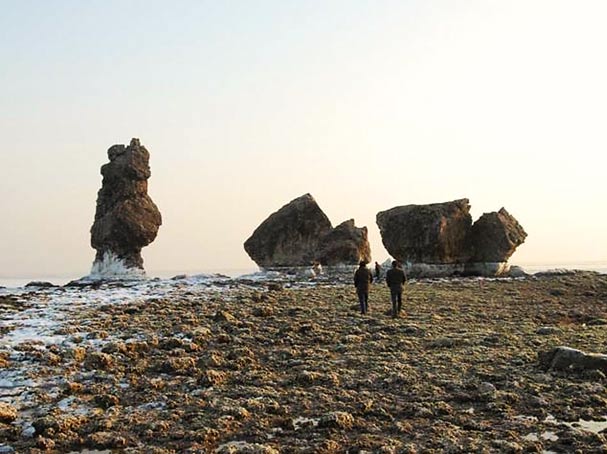Submerged Ruins May Be the Seaside Palace of the First Emperor of China
After three years of underwater archaeological investigations, archaeologists working in Suizhong county of the Liaoning province have said that they have made a very important underwater find - a seaside palace that was built more than 2,200 years ago for China’s first emperor, Qin Shi Huang.
TheChina Morning Post reports that the ruins are thought to date back to the Qin dynasty (221-207BC) and were discovered off the coast. Some of the granite stone walls are visible at low tide and local fisherman told the archaeologists that they recovered ancient coins and ceramics on the seabed.

Most of the remains of the Qin dynasty palace lie submerged off the coast of China’s Liaoning province. (Liaoshen Evening News)
So far the largest find has been a 60 meter (196.9 feet) wide square of large stones. The site’s archaeologiststhink that these could have been “the foundations of a large platform for religious sacrifices or other important activities.” They also told the press that they unearthed the remains of a stone road that passes through the building which they have identified as the palace.

Corridor paving stones found underwater at the site. (10333.com)
Qin Shi Huang was born as Ying Zheng in 259 BC. He is well-known for having not only been the first Emperor of China, but also bringing an end to theWarring States Period (475-221 BC) and uniting the country. During his rule he enacted many reforms in politics, the economy, and culture – some of which were positive and others negative.

Qin Shi Huang, the first emperor of China. (Public Domain)
- The Secret Tomb of the First Chinese Emperor Remains an Unopened Treasure
- Stone armour found in the tomb of China's first emperor
- The Mysteries of the Chinese Terracotta Warriors
- Human remains found in Mausoleum of First Emperor of China
Qin Shi Huang was also the one who ordered for the beginning of construction on theGreat Wall. The wall was initiated by the emperor to prevent attacks of the barbarian nomads. Although he did not live to see the final product (building it is estimated to have taken about 2,000 years), today the Great Wall is known as one of the most impressive construction projects and is a powerful symbol of China. Qin Shi Huang supposedly claimed that his dynasty would last for 10,000 generations.

A section of the Great Wall of China near Jinshanling. (Jakub Hałun/ CC BY SA 4.0)
Even though he tried to cheat it, death eventually caught up with the emperor. Perhaps some of the artifacts most associated with him are found in hismausoleum - the famedTerracotta Warriors. The unique features of these statues have led scholars to say that they were based one real people. The life-sized clay army was first discovered in 1974. More than 8000 strong and accompanied by their weapons and horses, the terracotta army is thought to have been created to protect the emperor in his afterlife.

Terracotta Army exhibition in Gdynia, Poland, August 2006. (Tomasz Sienicki/ CC BY SA 3.0)
That impressive army is perhaps related to one other interesting fact about China’s first emperor - he had an obsession with finding a way to live forever. During his quest for immortality, it issaid that Qin Shi Huang “visited the East China Sea coast three times.” If the archaeologists in Suizhong county are lucky, they may have found the emperor’s residence when he made those trips.
Featured Image: Archaeologists say that some ruins of the palace can be seen at low tide low. Source:Liaoshen Evening News



















